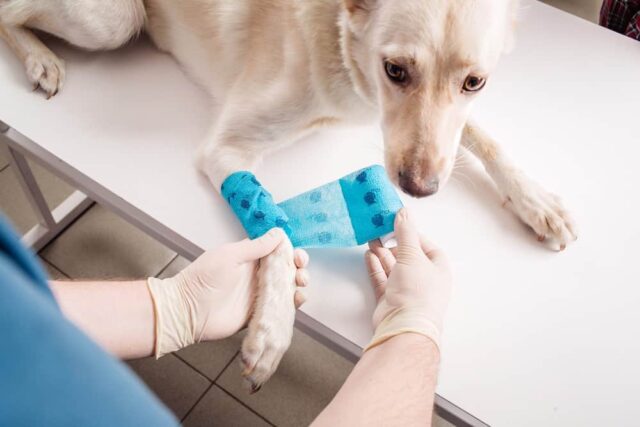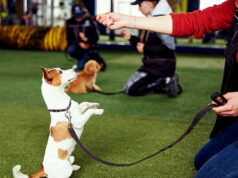
When our dogs suffer, we suffer too, so we will do everything to make it easier for them and find out what is bothering them. The problem arises because dogs often hide their pain, so we cannot react in time. They are super enduring animals, which makes it hard to figure out if they’re suffering and from what. They also have this amazing ability to be happy for other people, even though they’re in great pain. The reason for this is the ancestors lived in the wilderness where pain was a sign of weakness, so they learned to hide it.
Some dogs will be happy to come to you and ask for help, but often when they are injured or sick they choose to come to you only when the pain becomes unbearable. This is precisely why you should pay special attention to their behavior and signs that may indicate pain.

How can you recognize their pain and suffering?
There are some behavioral signs that may indicate something is wrong with their health, which you should pay special attention to. Read below and find out what they are so you can help your furry friend on time.
Look for any sign of distress
If you have noticed your pet manifesting restless behavior, it is an indicator that it may be experiencing pain. Especially if it is constantly pacing back and forth, finds it difficult to get comfortable, or sleeps much less, it could be a red alarm pointing out that the pain is difficult to bear.
Changes in body and posture
The easiest sign which shows your dog’s in pain is awkward body manifestations. Swelling of the paws, legs, and face is a sign of pain that can be caused by inflammation, infection, or even cancer. When they are in pain, some dogs have a very stiff and hunched posture, while others assume a position with their front legs on the ground and their rear in the air. They often adopt the so-called “praying” position when suffering from abdominal pain because it allows them to stretch that part of the body.

It shivers, shakes, or trembles
Shivering is not just a sign that it is cold or getting old. A dog that shakes or trembles can mean that it is in pain, or it could even be a symptom of something more serious such as poisoning, pancreatitis, or kidney disease. Dogs that have eaten large amounts of chocolate, moldy compost, or the sweetener xylitol often suffer from severe muscle tremors. So, make sure none of your kids were feeding it, sweets.
Limping
This symptom is very obvious and directly related to the existence of pain in a certain place. However, the causes can be different: in older dogs, the most common cause is arthritis, a disease that causes pain in the back and shoulders. These diseases are very common after 7-8 years and large dog breeds are prone to them. In these cases, pets often refuse to take the stairs or get up very slowly in the morning. When a dog gets old, it does not mean that it cannot be helped, so in such cases, take it to the vet who can suggest a medication which restores soft tissues, cartilage and joints, relieves pain and strengthens tendons.
Strong and bad breath
This symptom usually indicates a problem with the gastrointestinal tract, liver or kidneys. If the breath has a fruity smell and is accompanied by an excessive need to urinate, it may be a sign of diabetes. Odor that smells like urine can indicate that something is wrong with the dog’s kidneys, while extremely unpleasant breath accompanied by yellowing of the whites of the eyes and lack of appetite indicates liver problems.

Stomach problems
Smaller problems with the stomach, intestines and digestion are not easily recognizable. Excessive drooling can be a good indicator of nausea, and phenomena such as vomiting, diarrhea or constipation certainly indicate that your pet has some kind of stomach problem. With such problems, help your pet with a probiotic for dogs prescribed by a professional vet, that can usually work after 60 minutes, stabilizing the intestinal flora and the level of desirable bacteria in the stomach.
Bad mood
Just like people, they too can be moody when they’re not feeling well. If your pet drastically changes its mood from a happy, playful, friendly one and starts behaving moody, grumpy, and even aggressive, it can be a sign that it is exposed to some pain and that its tolerance threshold is reduced or it does not want to be in pain.
Licking
Intense licking of certain parts of the body such as paw pads, a broken nail, some wound… can be an indicator that something hurts in those places of the dog. This should not be ignored if an injury is not visible at first glance. Certain injuries such as a thorn, glass or parasite can be hidden deeper in the skin, so it is advisable to go to the vet.
When something bothers them or hurts them, dogs often, as we already mentioned, suffer in silence. Recognizing that a dog is in pain, whether from an injury or a health problem that is not easily visible, can be difficult because dogs do not have the ability to speak. However, above mentioned signs are more and less obvious, and may indicate that the dog is in pain. If you want to know how to help it, click here.

If you notice these signs, it is important not to try to treat your dog yourself. Many prescription medications for humans and pets can be very dangerous to dogs if taken without veterinary supervision. Therefore, it is important to consult a veterinarian and go with the dog for an examination. The following signs, i.e. changes in the dog’s behavior, may indicate that the dog is in pain and needs help.









